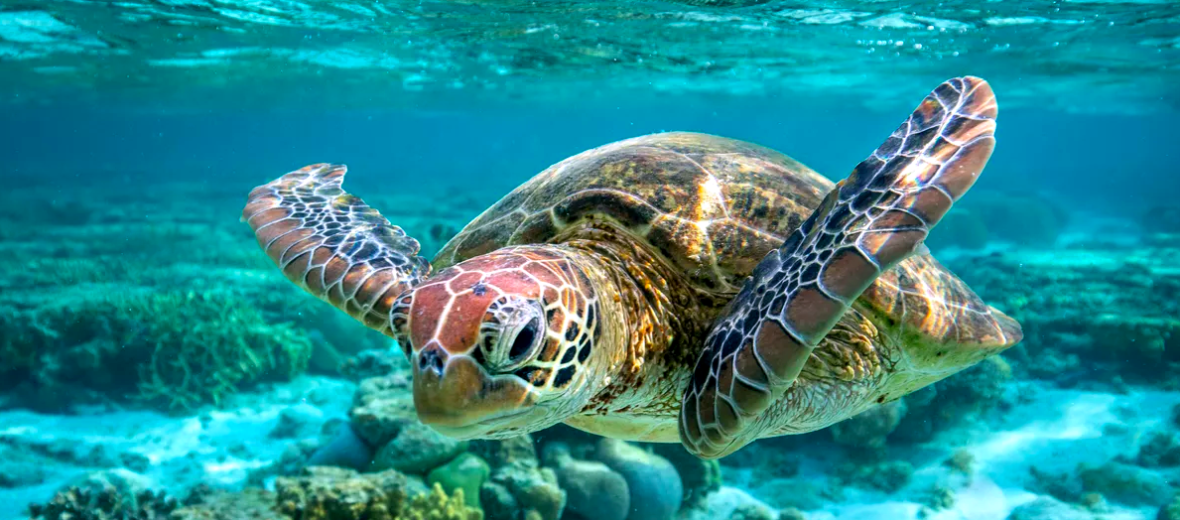
The green sea turtle, aka green turtle. Named not for the color of it’s skin or shell (carapass), but for the color of its fatty tissue and cartilage. These large oceanic turtles can be found in tropical and sub-tropical waters, worldwide. They are among the largest of the sea turtles and the largest hard-shelled sea turtle. This highly migratory species is listed as Endangered by the IUCN. The primary reasons are destruction of breeding grounds by hotels and resorts, over-harvesting of their eggs and young, climate change, pollution, and bycatch (getting caught in fishing gear). Sadly, their numbers are also decreasing.
First the Stats…
Scientific name: Chelonia mydas
Weight: Up to 350+ lbs.
Length: Up to 4.8 feet
Lifespan: Up to 35+ years
Now on to the Facts!
1.) Green turtles are strict herbivores that feast on sea grasses and algae. Hence their internal coloration.
2.) Their closest relative is the hawksbill turtle.
3.) Juveniles are carnivorous and typically eat fish eggs, jellyfish, molluscs, worms, small invertebrates, sponges, and crustaceans.
4.) Green sea turtles have a very slow rate of growth, due to their poor nutritional diet.
5.) As far as predation goes, adults only have humans and sharks (like the tiger shark) to fear.
But wait, there’s more on the green sea turtle!
6.) Juveniles have it pretty rough, as far as predators go. They are preyed on by crabs, small marine mammals, and shorebirds. Plus their eggs are feasted on by jackals and red foxes.
7.) They nest in 80+ countries and live in the coastal areas of 140+ countries.
Did you know…?
Green sea turtles migrate around 1,600+ miles to their nesting site, every 2+ years.
8.) Females lay up to 200 eggs per clutch. She has between 3 – 5 clutches per season.
9.) Sans predation, they also have parasitic organisms to contend with, like: barnacles, protozoans, cestodes, leeches, and nematodes.
10.) Fibropapilloma is caused by a herpesvirus that is transmitted by Ozobranchus branchiatus. This is a type of leech that feeds almost exclusively on green sea turtles.
But wait, there’s still more on the green sea turtle!
11.) Grazing on sea grasses helps maintain the health of the grass beds and the turtle’s waste is consumed by other organisms as well.
Did you know…?
An unfortunate result of humans moving in to turtle breeding grounds is that the hatchlings use the moon to navigate from the nest to the ocean. When buildings and streetlights shine at night, the lights confuse the baby turtles, who then navigate toward the lights and away from the ocean.
12.) Seagrass beds also serve as nurseries for numerous species of fish and invertebrates. These species, in turn, help the ocean and the economy too.
13.) Due to plastic being introduced into the ocean, many young green sea turtles perish as a result of consuming plastic bags, under the assumption they are jellyfish.
14.) Green turtles typically dive for about 3 – 5 minutes at a time and surface to breathe for about 1 – 3 seconds.
15.) These turtles sleep submerged for several hours at a time. Surfacing only to take a breath, then submerge again to continue sleeping.
Now a Short Green Sea Turtle Video!
Be sure to share & comment below! Also, check out the Critter Science YouTube channel. Videos added frequently!
Want to suggest a critter for me to write about? Let me know here.



